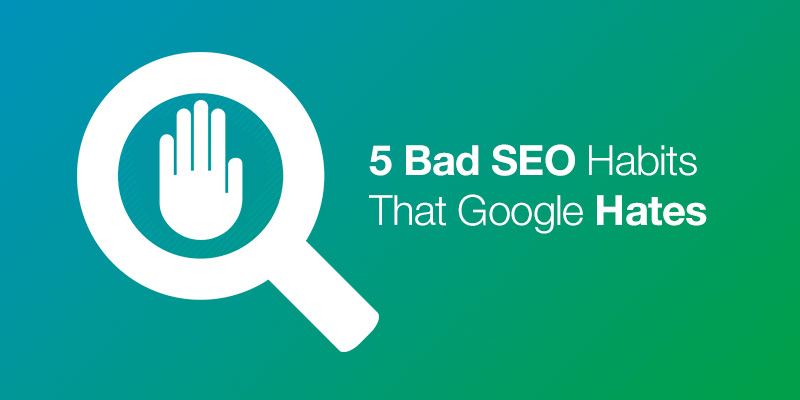Our blog
5 Bad SEO Habits That Google Hates

There’s an old saying: bad habits form from good intentions. When it comes to your site’s search engine ranking, it might be time to question some of these habits and ask yourself if they still work, or better yet, are they more of a hindrance than any help? To make it easier on you, here are five SEO habits that you need to break before Google gives your site the digital stink eye.
1. Keyword Stuffing
Keywords are crucial for clients to connect with your content, so making sure you’re using the right ones is SEO 101. However, some people tend to go overboard with the keywords. “Keyword stuffing” is cramming an excessive amount of keywords into a web page or meta description in an attempt to trick Google into sending more traffic your way based on said keywords.
In the early years of search engines and search based algorithms, this worked relatively well. But as of 2017? Forget about it. Any short-term benefits have become moot thanks to Google’s ever-evolving algorithm. Even if you somehow fall through the cracks, you’re unlikely to retain any traffic once the visitor realizes your page is full of buzzwords but has little content. In short, save the stuffing for Thanksgiving.
2. Spammy Internal Links
If keyword stuffing is verboten, then surely you can go as nuts as you want with internal site links, right? Wrong.
Think of your content as a good pizza. It took time to make, and it’s layered with facts, insight, and understanding. It comes across as balanced while still maintaining its aesthetic appeal. Now think of internal links as toppings. The content alone should be able to satiate the reader, but the toppings are extra–tasty bonuses of insight that can enhance the reader’s intellectual palate. Too many of them, however, turns off the reader/eater, who will feel overwhelmed by the bombardment of referrals and unrelated subjects.
The reasoning behind this habit isn’t wrong. After all, who doesn’t want to visitors to spend more time on their site? But it’s all about moderation and patience. Place your internal links wisely, and you’ll notice that your SEO relevancy is better for it.
3. Poor Affiliate Link Tagging
Affiliate links can be a tricky business if you’re relatively new to the world of SEO. It’s not that Google hates them; they just need to be handled differently. You see, Google differentiates between artificial and natural links, giving the latter higher priority to compensate for the traffic that affiliate links generate.
To avoid getting penalized for “unnatural links” simply add the nofollow tag, which tells search engines not to count it.
4. Inappropriately Named Images and Alt Descriptions
This one is more out of laziness than anything. Most people don’t bother giving their pictures proper file names, and it’s fine if you’re just taking a selfie, but it’s a sloppy mistake in the SEO game. Believe it or not, search engines do consider what you call your pictures. So, if you’re like most people who name their images things like “pic01.jpeg” or “X-4522.png,” then you might want to stop what you’re doing and rename them.
While people probably won’t care what your file names are, search engines certainly do.
5. Bait-and-Switch Redirecting
There’s no nice way to say it, and Google (and most people) considers this to be a scummy move. If you’re not familiar with bait-and-switch redirecting, it’s essentially buying a domain name with significant keyword value only for it to redirect to the webmaster’s main website.
For example, if you stumbled upon saddlewear.com through a search engine and were expecting horse saddle-related gear but you’re redirected to cleatworld.com, an online soccer store, that would be the equivalent of false advertisement. Thankfully, this throws a huge red flag on both domains and kills much of their search engine credibility.
Conclusion
Search engines are only going to get more sophisticated as time goes on. What’s acceptable today might not be two months from now. Always keep yourself search engine savvy by checking with Google’s Webmaster Guidelines.
